How to Consolidate Pages for SEO: A Step-by-Step Guide

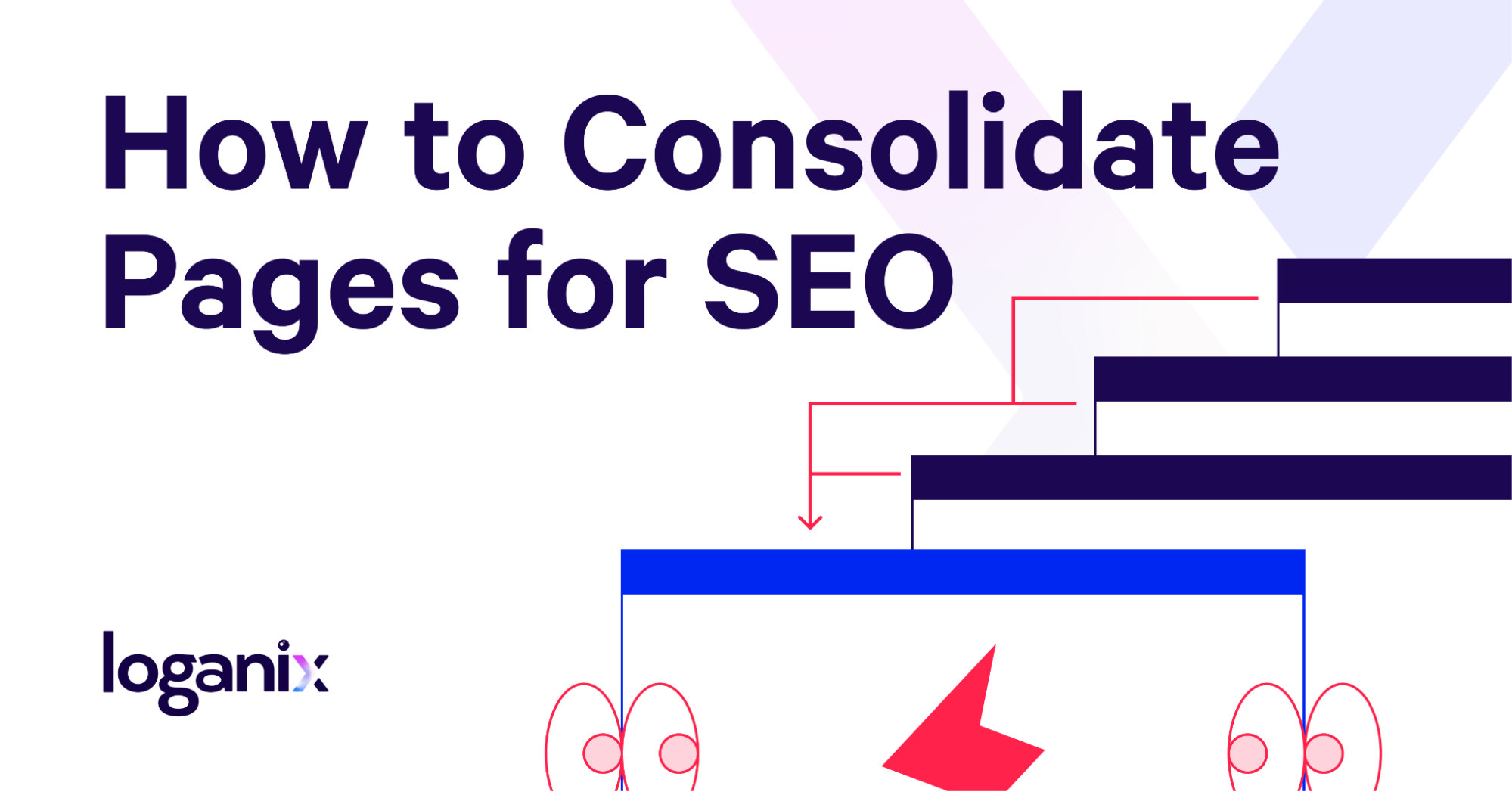
Hand off the toughest tasks in SEO, PPC, and content without compromising quality
Explore ServicesPages clashing over keywords, junk content weighing you down, and a messy structure that’s a nightmare for search engines and your users… it’s chaos I’ve seen a million times.
SEO consolidation’s the fix: slashing weak pages and merging the rest into something search engines can’t ignore.
You’ll rank higher, stop confusing crawlers, and quit wasting time on a bloated site.
I’ll walk you through why this matters, how to spot the culprits, and the exact moves to clean it up 👇
Why Consolidate Pages for SEO?
Real quick, here’s why you might consider consolidating pages for SEO:
- Reduces Keyword Cannibalization: When multiple pages target the same keyword, they’re not teammates; they’re rivals. Each one dilutes the others’ ranking potential, leaving you with a bunch of mediocre results instead of one well-performing page. Google doesn’t know which to pick, and your traffic gets sliced up like a bad pie.
- Eliminates Thin Content: Low-value pages—skimpy text, overused ideas, or outdated information—signal a lack of quality and authority. They drag down SEO, annoy users who bounce, and tell Google you’re not serious about delivering value.
- Boosts Efficiency: A site bloated with pages is inefficient. Search engines waste time crawling through the clutter, and users get lost trying to find what they need. Fewer, stronger pages streamline everything: faster indexing, better navigation, and happier visitors.
- Increases Authority: Link equity is your site’s currency, and scattering it across weak pages is a losing bet. Merge them, and you concentrate that power where it counts: on pages that are already performing well or are showing ranking potential. Plus, beefy, comprehensive content often looks like the real deal to Google and earns more respect (and links).
That’s the why. Let’s move on to the how.
Step 1: Identifying Consolidation Opportunities
Here’s how to track pages that need consolidating:
Keyword Cannibalization
How to spot it:

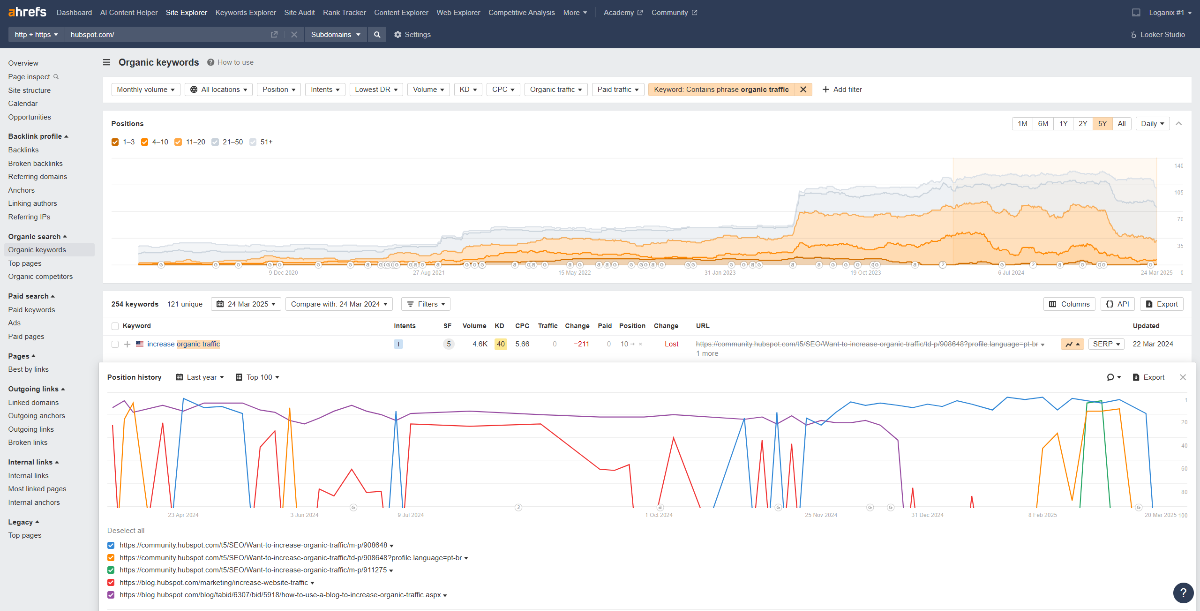
- Pop your site’s URL into Ahrefs’s Site Explorer.
- Go to the Organic keywords report. Here, you’ll find every keyword your site ranks for.
- Type in the specific keyword you’re worried about (e.g., “increase organic traffic”). This narrows it down.
- Click the ranking history dropdown. This shows you which URLs have ranked for that keyword over time. If multiple pages are showing up, with their lines intersecting like they are in the example image above, you’ve got potential cannibalization issues.
- Use your discernment here. Naturally, pages will rank rank for the same secondary keywords, but consistent overlap of primary keywords means they’re stepping on each other’s toes and that’s a problem worth fixing.
- Export the URLs and save them for later (I’ll show you what to do with them soon).
Thin Content


Head to Google Analytics. Check for pages with high bounce rates (people leaving fast), low engagement metrics (like short time on page), or low conversions (if it’s a product page like the example above). These are the culprits, pages that just don’t deliver.
Low Traffic/Engagement


How to identify:
- Back to Ahrefs. Filter your organic traffic data for pages with under 50 visits.
- If they’ve been live for a while and still can’t draw a crowd, they’re ripe for a refresh or consolidation.
Mapping Keywords to Pages
You’ve pinpointed the culprits. Now, it’s time to take control, map your keywords, and give each page a clear path forward.
Here’s the plan in three steps:
1. Research Primary Keywords
You need to target the right keywords. Keywords your audience actually searches for when they’re after what you’ve got. Start broad with industry terms, what is known as seed keywords.
- Brainstorm your seed keywords. You can do this yourself or lean on an AI tool like ChatGPT to do this for you.


- Plug the brainstormed keywords into Ahrefs’ Keywords Explorer for a list of related terms, plus search volume and difficulty scores.

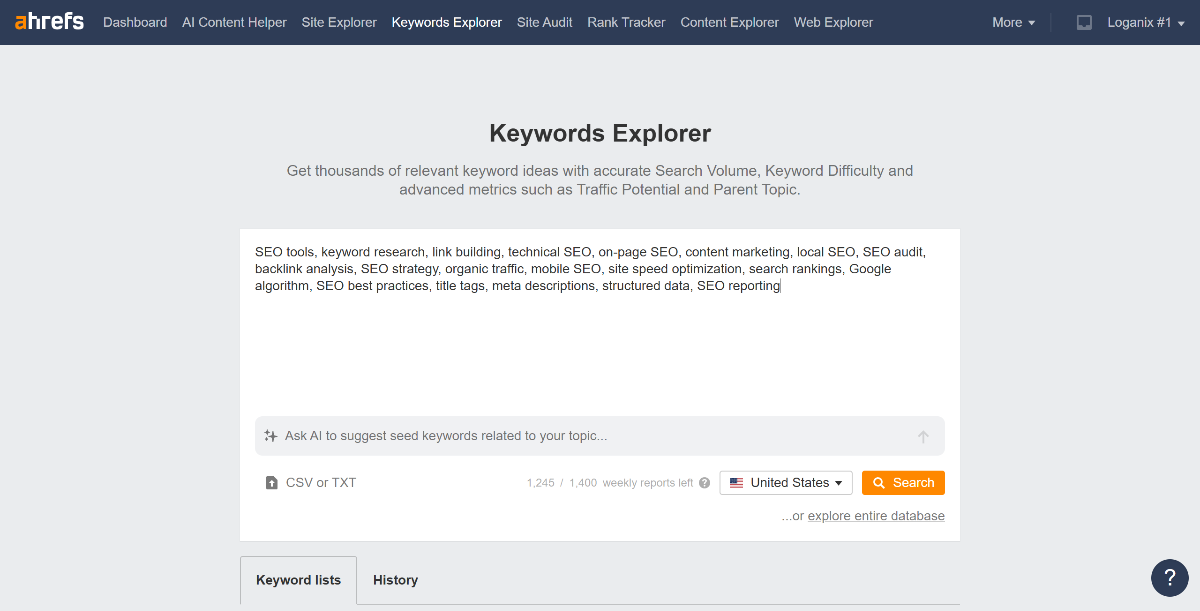
- From the left-hand side navigation menu, select Matching terms and then pick your primary keywords—the terms each page will rank for. Go for:
- Relevance to your business
- Filter for decent search volume (100+ monthly searches)
- Filter for manageable competition (whatever matches your site and topic authority)
- Export the entire list as a CSV file.

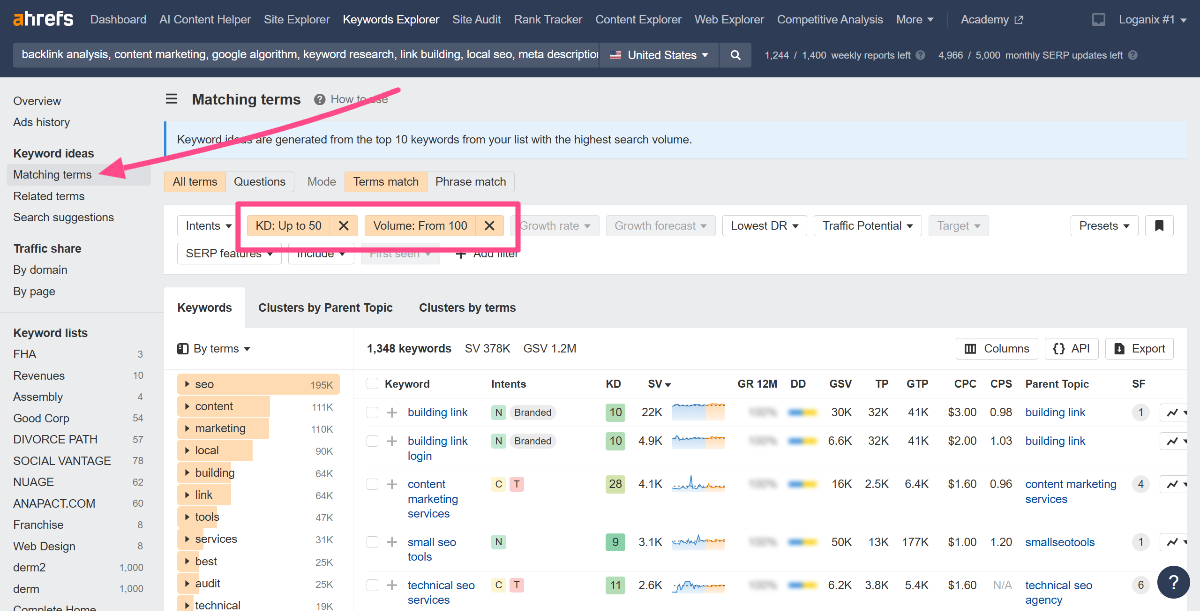
2. Create a Keyword Map
Assign one primary keyword per page. A spreadsheet works best:
- Columns: URL, Primary Keywords, Secondary Keywords
- This is a mammoth undertaking, particularly for large websites. I like to lean on AI tools to help me out here:
- Download the site’s XML sitemap as a PDF file
- Get your matching terms keyword CSV file we just downloaded ready
- Take both assets and give them to ChatGPT
- Then use the following prompt:
“I have two assets:
- A CSV file that contains a keyword list.
- An XML sitemap file containing the URLs of a website.
Analyze all the URLs in the sitemap and assign the most relevant keyword(s) from the keyword list to each URL (if provided, include any relevant information relevant to the provided keywords, including search volume, KD, etc.).
Tabulate the output. Expected columns:
URL: The URL of the page.
Primary Keyword: The most relevant keyword for the page.
Secondary Keywords: Any additional relevant keywords for the page.
If provided, additional columns for search volume, KD, etc.
When assigning keywords, prioritize accuracy and relevance. If a URL does not match, remove it from the table.”
Here’s GPT’s output:


3. Head to Ahrefs’ Organic Keywords report in Site Explorer, export the list of keywords that each page is currently ranking for and cross-reference it with the CSV file of matching terms. Adjust your map to reality, then plan your fixes.


4. Keep in mind that this method is by no means perfect. ChatGPT will give you a good starting point and save a bunch of time, but I’d highly recommend you manually check over the list to make sure its keyword-to-URL aligns with your content strategy.
3. Flag Overlaps
Here’s where you build on Step 1’s cannibalization hunt. Scan your finalized keyword map. If any primary keywords are showing up more than once, it’s a red flag.
- Double-check with the Ranking History from Step 1: consistent overlap means those pages are working against one another.
- Decide their fate:
- Merge: Combine pages with similar primary keywords into one beefy, authoritative piece.
- Redirect: Point the weaker page to the stronger one with a 301.
- Repurpose: Rewrite one to target a new primary keyword if it’s worth saving.
Example: Two pages both chasing “lead generation”? Merge them into a single guide and redirect the loser’s URL.
Auditing Content Quality
Every page on your site should have a purpose, or it’s just clutter. Auditing content quality is about deciding which pages deserve to stay, which can be combined for more impact, and which needs to go.
Here’s how to do it right:
Assess Relevance
Start by asking: is this content still useful and current? Outdated or off-target pages drag your site down. Dig in with these questions:
- Does this page support your site’s current goals?
- Is the information fresh, or is it stuck in the past?
- Would you share this with a visitor without cringing?
If a page feels irrelevant or stale, it’s a candidate for updating or the trash bin.
Check Performance

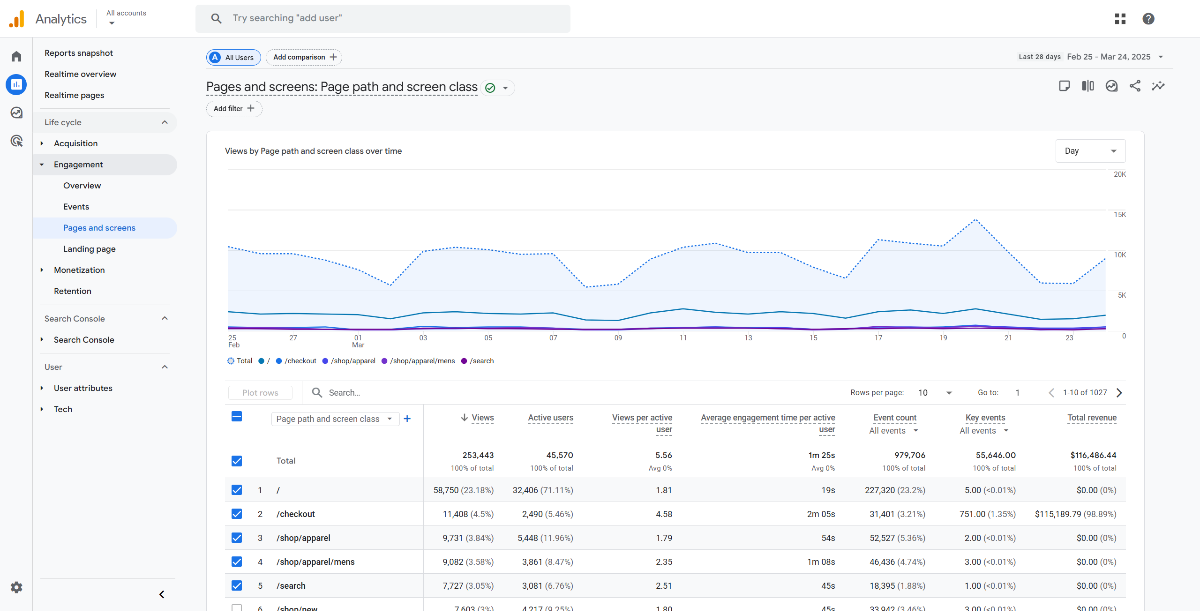
Data doesn’t lie. Open Google Analytics and pull these key metrics:
- Traffic: How many people visit this page? Low traffic could mean it’s not pulling its weight.
- Engagement: Look at bounce rate and time on page. High bounces or short visits signal weak content.
- Conversions: Does it drive your goals: sales, sign-ups, whatever? No results, no reason to keep it.
Pages that shine here are worth keeping. Stragglers need a hard look.
Review Backlinks

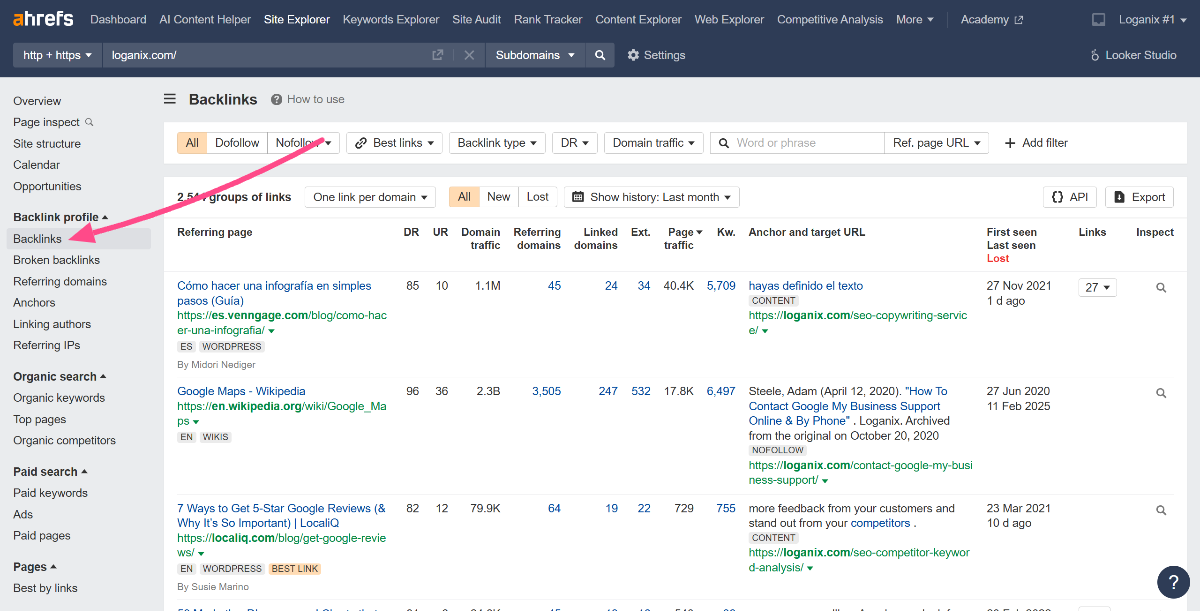
Backlinks can tip the scales. Use a tool like Ahrefs to check:
- Does this page have backlinks? If so, ask yourself this follow-up question:
- Are the links worth saving? If they are, keep or 301 redirect the page to preserve that SEO juice.
No backlinks, low traffic, and thin content? That’s an easy delete.
Decision Guide
Time to sort the keepers from the losers:
- Keep: High-performing, relevant pages with solid traffic, engagement, or backlinks. These are your site’s backbone; protect them.
- Merge: Pages that overlap in topics or target the same keywords. Combine them into a single, stronger page to consolidate authority and streamline the user experience.
- Delete: Irrelevant, low-value pages with no backlinks or traffic. They’re dead weight; cut them.
Merging and Redirecting Pages
The goal here? To combine overlapping pages into a single, authoritative “hero” page that keeps your traffic flowing and your rankings intact.
Here’s how to do it right, step by step:
Pick the Hero Page
Your hero page is the keeper, the one you’ll build on. Choosing the right one is critical because it’ll inherit the SEO value from the pages you’re merging. Here’s what to consider:
- Traffic: Check your analytics. Which page gets the most organic visitors? That’s a strong starting point.
- Quality: Is the content detailed, fresh, and user-friendly? A high-quality page is easier to enhance.
- Backlinks: Use a tool like Ahrefs to see which page has the most (and strongest) backlinks. More backlinks equal more authority to carry forward.
If one page shines in all three, it’s your hero. If not, lean toward the page with the best SEO signals—like backlinks—and plan to polish its content during the merge.
Merge Content
Now, take the best pieces from your secondary pages and weave them into the hero. Here’s how:
- Spot the highlights: Pull out unique insights, stats, or sections from the secondary pages that add value to the hero.
- Blend it smoothly: Restructure the hero page to fit the new content naturally Think seamless, not stitched together.
- Polish it up: Update outdated info, improve readability, and ensure it flows as a single, cohesive story.
When you’re done, the hero page should feel richer and more authoritative than ever.
Set Up 301 Redirects
With your hero page ready, redirect the old pages to it using 301 redirects. This tells search engines the move is permanent, passing most of the SEO value to the hero. Why it matters:
- Preserves link juice: Backlinks to the old pages now power up the hero.
- Keeps users on track: Traffic to old URLs flows smoothly to the new one.
- Avoids dead ends: No 404 errors, no lost visitors.
To set this up, add redirect rules to your .htaccess file (on Apache servers) or use a plugin like Redirection on WordPress. If tech isn’t your thing, rope in a developer. This step’s too big to mess up.
Optimizing Consolidated Pages
You’ve merged your pages, great, you’re halfway there. Now it’s time to juice up that new consolidated page:
Update Title Tag and Meta Description
First stop: your title tag and meta description:
- Title Tag: Shove your primary keyword in there, front and center. None of this bury-it-at-the-end nonsense. Keep it under 60 characters so Google doesn’t chop it off.
- Meta Description: You’ve got 150-160 characters to hook potential visitors. Use the keyword, sure, but sell the click: why’s this page worth their time? Tell them.
Enhance Content
Your content’s got to flex now that it’s the hero page:
- Headers: Use H1 for the main title (keyword included, duh), then H2s and H3s to break it up logically. Clear headers aren’t just for SEO bots. They keep users from bouncing when they can skim and still get it.
- Comprehensive Info: This page should be the last word on the topic. If you merged three posts about “digital marketing,” cover every angle—SEO, PPC, social—like it’s the only resource they’ll ever need. Beef it up with stats, examples, whatever makes it stick.
Optimize Images
Images are important, too:
- Alt Text: Describe the image with your keyword naturally woven in. It’s for Google and screen readers, so don’t skip it.
- Size Reduction: Compress those images. Slow pages annoy even the most patient visitors everyone.
Tip: Run it through an SEO plugin like Yoast for a quick gut check. It’ll flag if your keyword’s MIA or your meta’s too long. Don’t obsess over green lights, just use it to catch the obvious screw-ups.
Updating Internal Links
You’ve consolidated your pages: hero pages are crowned, weak ones are axed or merged. Awesome! But if you don’t update your internal links, you’re leaving landmines all over your site. Broken links that frustrate users and bleed link equity dry.
Here’s how to avoid that:
Find Links
First, you’ve got to hunt down every internal link pointing to those old, now-redirected pages. Don’t guess. Instead, use a crawler like Ahrefs’s Site Audit to do the dirty work.
- Pop your site’s URL into the Site Audit tool (if this is your first time doing this, you’ll need to hook up Ahrefs manually or through your Google Search Console account).
- Once you’re set-up, run a fresh audit.
- Once it’s done, under Reports, select the Links report. Then, click on the Broken internal links.

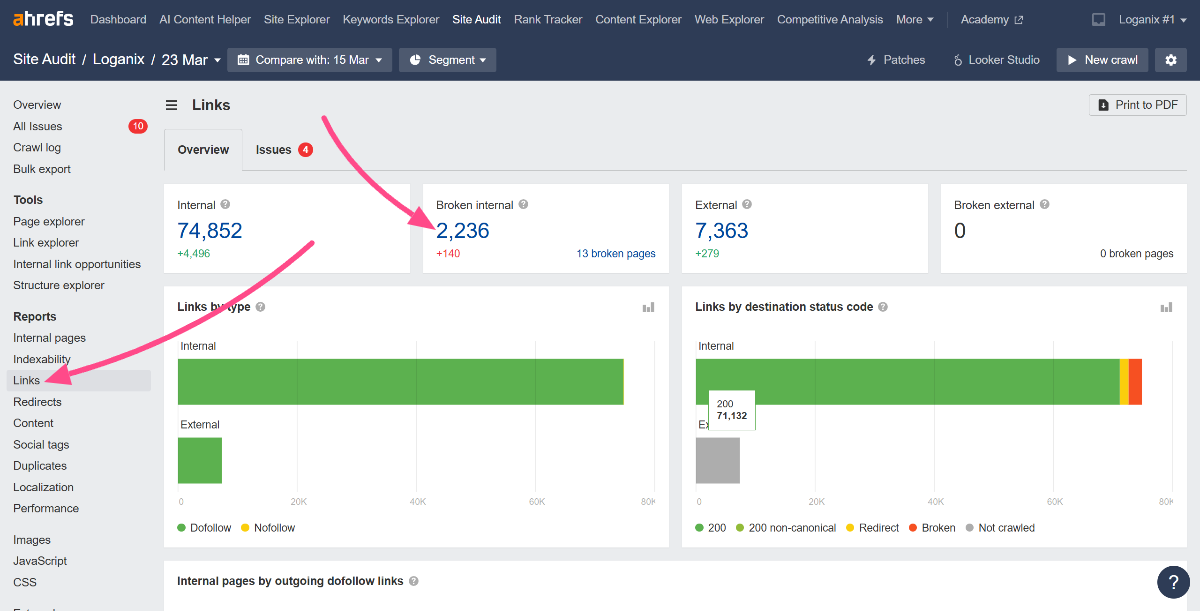
- Export the list (we have 2,236. Yikes! We have some work to do). Scan the CSV file for any links still pointing to the old URLs you consolidated.


Update Them
Found the stragglers? Good. Now, point every single one to your shiny new hero page.
- Open your CMS (WordPress, Shopify, whatever you’re rocking).
- Hit up each page from your export list and swap the old URL for the hero page’s URL.
- Double-check the anchor text.
- If it’s a big site, automate it with a find-and-replace script (just don’t break anything; test it first).
No excuses! Every link needs to lead to the consolidated page, or you’re just begging for 404s.
Measuring Impact on Traffic and Rankings
Now what? You need to know if it actually worked, not just hope it did. Here’s how to check:
Track Keyword Rankings
First up, see if your rankings moved:
- Google Search Console: Hit the Performance report. Filter for your primary keyword and compare average positions pre- and post-consolidation. A jump from page 2 to page 1? That’s the win you’re after.
- Semrush: Use the Position Tracking tool. Plug in your domain, add your target keywords, and watch the trend. If your hero page is climbing while the old URLs fade, you’re golden.
Monitor Traffic


Next, check the traffic flow. Did consolidation bring more visitors, or are you still preaching to an empty room? Google Analytics is your go-to here.
- Head to Acquisition > Traffic acquisition, then filter for Organic Search.
- Look at sessions to your hero pages. Compare the last 30 days before consolidation to the 30 days after. More sessions mean more eyeballs, plain and simple.
Assess Results
Rankings and traffic are half the story. Did users actually stick around and do something useful? Time to judge engagement and conversions.
- Bounce Rate: Lower than the old pages’ average? Good. You’re keeping people hooked. Still sky-high? Your content’s not cutting it.
- Time on Page: Higher time on page means users are digging in, not bolting. If it’s under 30 seconds, you’ve got a snoozer.
- Conversions: Think form fills, purchases, whatever matters. If your hero page is driving more action than the old ones combined, you’ve cracked it.
Conclusion and Next Steps
If your traffic’s up, bounce rates are down, and conversions are ticking, you’ve got a win.
If not, tweak it. SEO’s a grind, not a one-and-done.
But let’s be real: not everyone’s got the time or stomach to wrestle with this stuff solo.
Audits, redirects, optimization… it’s messy, and screwing it up can tank your site’s traffic.
That’s where we come in. At Loganix, we live for this stuff: ripping apart your site’s weak spots, consolidating like champs, and turning it into a lean, mean ranking machine.
👉 Hit up our SEO services page, and let’s get your site firing on all cylinders. 👈
Hand off the toughest tasks in SEO, PPC, and content without compromising quality
Explore ServicesWritten by Aaron Haynes on April 6, 2025
CEO and partner at Loganix, I believe in taking what you do best and sharing it with the world in the most transparent and powerful way possible. If I am not running the business, I am neck deep in client SEO.













